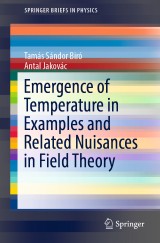Details

Emergence of Temperature in Examples and Related Nuisances in Field Theory
SpringerBriefs in Physics
|
53,49 € |
|
| Verlag: | Springer |
| Format: | |
| Veröffentl.: | 07.02.2019 |
| ISBN/EAN: | 9783030116897 |
| Sprache: | englisch |
Dieses eBook enthält ein Wasserzeichen.
Beschreibungen
<p>Field theory, relying on the concept of continuous space and time while confronted with the quantum physical nature of observable quantities, still has some fundamental challenges to face. One such challenge is to understand the emergence of complexity in the behavior of interacting elementary fields, including among other things nontrivial phase structures of elementary matter at high energy density or an atypical emergence of statistical properties, e.g., when an apparent temperature is proportional to a constant acceleration in a homogeneous gravitational field. </p><p></p>
Most modern textbooks on thermal field theory are mainly concerned with how the field theory formalism should be used if a finite temperature is given. In contrast, this short primer explores how the phenomenon of temperature emerges physically for elementary fields - inquiring about the underlying kinetic field theory and the way energy fluctuations and other noise should be handled - and it investigates whether and how this harmonizes with traditional field theory concepts like spectral evolution, the Keldysh formalism, and phase transitions.<p></p><br>
Most modern textbooks on thermal field theory are mainly concerned with how the field theory formalism should be used if a finite temperature is given. In contrast, this short primer explores how the phenomenon of temperature emerges physically for elementary fields - inquiring about the underlying kinetic field theory and the way energy fluctuations and other noise should be handled - and it investigates whether and how this harmonizes with traditional field theory concepts like spectral evolution, the Keldysh formalism, and phase transitions.<p></p><br>
Preface.- Off-shell and on-shell transport.- Uncertainty, Wigner function and Unruh temperature.- Feynman-Vernon path integral.- Keldysh (two-time) formalism.- Noise from renormalization?.- Distribution of local energy packets.- Melting of spectra.
<div>Tamás Sándor Biró born at March 22, 1956 in Budapest I was half a year old at the time of the Hungarian Revolution. It prevented my parents from trying to make their living in the West, unlike many other fellow Hungarians did. I studied physics at Eotvos University from 1975 til 1980, and then received a diploma (equivalent to MSc) in physics and biophysics. I achieved my PhD degree at the same university (dr.rer.nat.) in 1982 based upon a research in theoretical heavy ion physics, about strange quark production in quark-gluon plasma, supervised and guided by Prof. Zimanyi. I continued my carreier as researcher at the Central Research Institute for Physics, Budapest, at the Niels Bohr Institute, Copenhagen, at the GSI, Darmstadt until 1984. Then I took an opportunity in 1985 to join to the Institute fur Theoretische Physik at the University of Giessen, Germany, where I stayed until my return to Budapest in 1994. Habilitation in theoretical physics in 1991, and an academic DSc degree in Hungary in 1994 signed some academic qualication of my eorts. I suggested the color rope model for describing the early phase of ultrarelativistic heavy ion collisions in 1983, took part in studies of chaotic dynamics in strongly interacting non-abelian gauge elds (1991-1999), then developed more and more a feeble for statistical physics of complex systems. Since 2005 I was active on studying and improving non-extensive thermodynamics.</div><div><br></div><div><div>Since 2013 I am vice director of the Institute for Particle and Nuclear Physics, the half of the</div><div>Wigner Research Centre for Physics, in Budapest. I had the pleasant opportunity to collaborate</div><div>with colleagues spread over the world: Duke University in North Carolina, US, Bergen University</div><div>in Norway, University of Cape Town and of Johannesburg, South Africa, Central China Normal</div><div>University in Wuhan, China, Yukawa Institute in Kyoto, Japan and some other places. I am also</div><div>trying to help the research communities with editorial work: Acta Physica Hungarica, followed by</div><div>the EPJ A (Hadrons and Nuclei), where my term as Editor-in-Chief just ends soon (September</div><div>30, 2018).</div><div><div>By now we are witnessing a restructuring of the Hungarian research support landscape, by</div><div>establishing a new Ministry for Innovation and Techology and attaching the research institute</div><div>network to this ministry (formerly maintained by the Hungarian Academy of Science). Looking</div><div>forward to new challenges with new exciting possibilities for the research activity here.</div></div></div>
Diese Produkte könnten Sie auch interessieren:

Introduction to Focused Ion Beams

von: Lucille A. Giannuzzi, Lucille A. North Carolina State University

128,39 €















